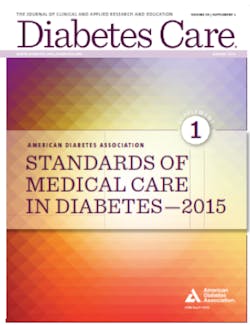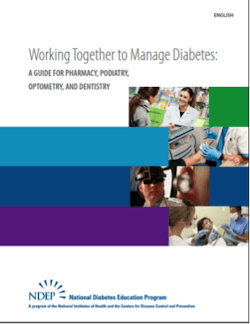I recently attended a meeting sponsored by the Diabetes Coalition of California. I learned so much! I will share the information and resources in subsequent newsletters. This article will focus on new diabetes information relevant to our patients and families.
We all know that there is a connection between oral and general health and now Anthem Blue Cross and Blue Shield understands this as well. They developed a program that considers the comprehensive health of its dental and medical members via the Anthem Whole Health Connection program. (1) They feel that integrated benefits will provide many helpful advantages for dental and medical members. Effective January 1, 2015, members who participate in Anthem Blue Cross and Blue Shield’s Dental Blue, Dental Prime or Dental Complete1 plans and are actively managed in one of the company’s Diabetic or Maternal Health Care Management programs will be identified and automatically enrolled at no cost for an extra dental cleaning or periodontal maintenance procedure per benefit period. Hooray! It is positive that there is increasing recognition that diabetes is associated with the increased occurrence and progression of periodontitis and that periodontitis has been called the sixth complication of diabetes (for both type 1 and type 2 diabetes).
In general health, type 2 diabetes is realized as a risk factor for pancreatic cancer, and the incidences of both pancreatic cancer and type 2 diabetes are increasing. In a meta-analysis of nine prospective observational studies, researchers evaluated the dose-response association between blood glucose concentration and risk for pancreatic cancer. (2) Through the whole range of blood glucose concentrations, a strong linear dose–response relation was noted between fasting blood glucose concentration and incidence of pancreatic cancer. Every 10.1 mg/dL increment in fasting glucose was associated with a 14% increase in incidence of pancreatic cancer. Similar results were obtained when only fasting blood glucose concentrations in the prediabetes range were considered. The authors state that their results are biologically plausible. Their evidence proposes that hyperglycemia promotes cell proliferation, and hyperinsulinemia promotes cell proliferation and reduces apoptosis. Preventing and treating prediabetes and type 2 diabetes, by improving diet, physical activity, and weight loss, may be a significant prospect for preventing pancreatic cancer. (2)
The American Diabetes Association (ADA) has recently published a new document on standards of medical care to help improve patient care:“Diabetes mellitus is a complex, chronic illness requiring continuous medical care with multifactorial risk reduction strategies beyond glycemic control. Ongoing patient self-management education and support are critical to preventing acute complications and reducing the risk of long-term complications. Significant evidence exists that supports a range of interventions to improve diabetes outcomes. The ADA’s Standards of Care are intended to provide clinicians, patients, researchers, payers, and other interested individuals with the components of diabetes care, general treatment goals, and tools to evaluate the quality of care. The recommendations include screening, diagnostic, and therapeutic actions that are known or believed to favorably affect health outcomes of patients with diabetes. Many of these interventions have also been shown to be cost-effective." (3)
In other news, long-term cognitive decline was significantly greater among patients who had diabetes at midlife compared with those who did not. (4) In this community-based cohort study, the association between diabetes and cognitive decline was thought to be due mainly to deficiencies in processing speed and executive function, processes usually related to white matter pathways and subcortical gray matter that typically are affected by cerebrovascular disease. (4)
And surprise, there is another type of diabetes! While many are all familiar with type 1 and type 2 diabetes, most do not know about monogenic diabetes. (5) Different types of monogenic diabetes include neonatal diabetes and maturity onset diabetes of the young (MODY). Monogenic diabetes occurs when there is a mutation in a single gene of the diabetic person. The human body has about 30,000 individual genes. So far, more than 20 genes have been linked to monogenic diabetes. A mutation in any one of these genes can cause a child or adult to develop monogenic diabetes. MODY is most commonly caused by mutations in the HNF1A gene or the GCK gene; neonatal diabetes is most commonly caused by mutations in the KCNJ11, ABCC8, or INS genes. This type of diabetes is still a bit of a mystery to researchers. For more information, visit the University of Chicago Medical Center, Kovler Diabetes Center.
ADDITIONAL READING | Diabetes: A new toolkit
And to end with positive news, researchers in St. Louis discovered a way to prevent type 1 diabetes in an animal model. (7) The team focused on blocking the autoimmune process that destroys beta cells and leads to diabetes, with the goal of developing therapies that can prevent the illness from developing rather than treating its symptoms. Let’s hope we learn more about this in the near future.
Maria Perno Goldie, RDH, MS, is the editorial director of RDH eVillage FOCUS.
References
1. Anthem Blue Cross and Blue Shield offers third dental cleaning and periodontal maintenance visit to pregnant and diabetic members. Anthem. https://www.anthem.com/health-insurance/about-us/pressreleasedetails/IN/2015/1790/anthem-blue-cross-and-blue-shield-offers-additional-dental-benefit-to-pregnant-and-diabetic-members-in-2015. Accessed February 3 2015.
2. Liao W-C, Tu Y-K, Wu M-S, Lin J-W, Wang H-P, Chien K-L. Blood glucose concentration and risk of pancreatic cancer: Systematic review and dose-response meta-analysis [published online ahead of print January 20 2015 ]. BMJ. 2015;349:g7371. http://dx.doi.org/10.1136/bmj.g7371.
3. American Diabetes Association. Standards of medical care in diabetes—2015. Diabetes Care. 2015;38(suppl1) Volume 38, Supplement 1. January 2015. pp S1 – S94. http://professional.diabetes.org/admin/UserFiles/0%20-%20Sean/Documents/January%20Supplement%20Combined_Final.pdf.
4. Rawlings AM, Sharrett AR, Schneider AL, et al. Diabetes in midlife and cognitive change over 20 years: A cohort study. Ann Intern Med. 2014;161:785-793.
5. What is monogenic diabetes? University of Chicago Medicine: Kolver Diabetes System. http://monogenicdiabetes.uchicago.edu/what-is-monogenic-diabetes/. Accessed February 3 2015.
6. Li Y, Lu Z, Zhang X, et al. Metabolic syndrome exacerbates inflammation and bone loss in periodontitis. J Dent Res. 2015;94:362-70.
7. Solt LA, Banerjee S, Campbell S, Kamenecka TM, Burris TP. ROR inverse agonist suppresses insulitis and prevents hyperglycemia in a mouse model of type 1 diabetes [published online ahead of print January 5 2015]. Endocrinology. 2015;en.20141677. doi: 10.1210/en.20141677.









